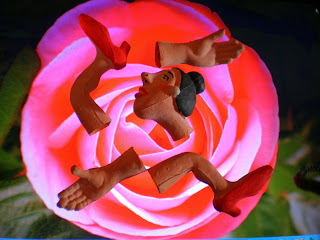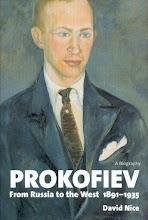
Would that it were so, that I might bask in the reflected glory of my fellows in Prokofiev studies. Earlier this year, in May, hopes ran high indeed when scholar Simon Morrison came to Goldsmiths to demonstrate so eloquently what Prokofiev's original thoughts on
Romeo and Juliet might sound like (hopefully encapsulated as clearly as I could manage back in this
blog entry).
When the Mark Morris Dance Group came to the Barbican last week, we did indeed get the promised happy end of the original 1935 score, in which following Friar Laurence's timely intervention, Juliet stirs in the nick of time and the lovers get to dance again in a fantasy-world of their own. Above is the perfectly photogenic pair I saw on Saturday night, Maile Okamura and Noah Vinson, as photographed for the Barbican Centre by Gene Schiavone. I guess Morris did as well as he could with that unlikely premise (which Simon thinks, perhaps debateably, is the result of Prokofiev's Christian Scientific beliefs in the best of all possible worlds). Otherwise, this choreographer can either rise to the heights of genius, as in the almost unbearable lightness of his exultant approach to Handel's
L'allegro, il penseroso ed il moderato, or he can be horribly disappointing. And I'm afraid that I, and those around me, were disappointed by what he'd come up with for an alternative
Romeo.
It wasn't quite as dire an evening as
Michael Clark's Stravinsky project in the same theatre, and certainly improved in the first part of the third act. Still, there was nothing radical except for a desire to squeeze in a bit more of the Shakespearean story line - though usually when the music, especially in the little codas, is trying to focus on the characterisation - and no chance of rivalling the sumptuousness of the indestructible and now far from routine Kenneth MacMillan classic at the Royal Ballet. The Morris crowd scenes, according to J (and I can only concur), looked a bit like the valiant efforts of our friend Danni - formerly Danielle Sophia of the 'Tumbling Elsters' - and her fellow hoofers in the annual Poole showbiz revue. Which is not to belittle the latter, only to point out that they're amateurs in the best sense, and this lot are supposed to be professionals. I fear I can't bring myself to illustrate the Morris group in this, so let's have a comforting sideways view of how the Capulet ball ought really to look in the Royal Ballet production, courtesy of Dee Conway.

Yes, I know it's probably time for something new, but there's more vitality in a minute of that heart-in-mouth show than in the three long hours we spent at the Barbican. Occasionally Morris gives his company an interesting and graceful pattern to execute, but where were the testosterone of violent Verona or the panache of youthful high spirits? Maybe there was a point in having women play Mercutio and Tybalt - and Amber Darragh's prankster stood out as better than the rest, though that's not saying much - but surely less cliched gestures could have been found for such numbers as the Dance of the Knights.
Morris's steps frequently reach a standstill while the dancers look as if they're thinking what to improvise next. You need a lyric and dramatic sweep, and it reminded me how of how, in total contrast, Nureyev used to be criticised for 'overfilling' his choreographies. But that came out of being head over heels in love with the physical act of dancing, and on Saturday I could only hark back to having watched (as part of my DVD ballet batch for the
BBC Music Magazine) Nureyev's Paris Opera Ballet
Cinderella on Opus Arte, lavishly restored after his death with the wistful-lovely Agnes Letestu (such arms, such telling expressions - shouldn't dancers act intensely with their faces as well as their bodies? They certainly tend to now at the Royal Ballet). Given the relocation to Hollywood in the 1930s, there are Chaplin, Groucho, Fred-and-Ginger, Keystone Cops and even King Kong routines. Some ideas work, others don't, but it's all alive.

But back to Saturday. Compound Morris's often tentative, sketchy steps with the unhappy situation of the reduced pit orchestra confined to the shoebox under the stage - supposedly the LSO, though there were quite a few deps on Saturday night - and the tough set-pieces could only turn out to be damp squibs winning no applause. Conductor Stefan Asbury had an easier task making the more intimate music of Act Three glow, and briefly our lovers shone in the buff. But Morris really hasn't taken advantage of all the dance vocabulary which has accrued since Balanchine to give his Romeo and Juliet their own special eloquence and poetry, and this is probably the only 'balcony scene' where instead of being moved to tears I found that my mind was elsewhere.
Given that the bitty original ending was immeasurably improved in Prokofiev's tragic rewrite, that we only lose one dance which might be worth hearing and that the first version doesn't cut down on all the crowd-reprises of Act Two as I'd expected, this will surely turn out to have been a once-only outing. I'm glad Simon has put in all that work, especially so that we could hear where the music of the Fifth Symphony's scherzo fits in an improbable last-minute melee, but it would be a mistake to plead that 'this was what Prokofiev wanted'. First thoughts are rarely the best; revision makes perfect - equally true, in my opinion, of Musorgsky's
Boris Godunov, Tchaikovsky's
Romeo and Juliet and Sibelius's Fifth Symphony (though there's more interesting stuff in all of those Version Ones).
Anyway, I'm glad that the geniality of the Prokofiev Association's 25th anniversary party before the performance on Thursday wasn't immediately blunted by my experience of the ballet (which I saw two nights later). Many of the Prokofievs were there, though Sviatoslav had felt too unwell the day before he was due to travel. Here, at least, is his son, Serge Junior, who looks more like his grandfather than either Sviatoslav or the late and much-missed Oleg, and whose designer's eye gave us the splendid image of 25 Sergey Sergeyeviches on the invite. My beloved Noelle Mann, guiding force of the association, journal and archive for so many years, holds it aloft for inspection.

Simon, of course, was there, seen on the right with a distinguished Russian colleague, now based in Tel Aviv, who's also contributed invaluable research on the history of Prokofiev's
Romeo, Nelly Kravetz.

Lady Joan Downes wanted me to take this photo from a distance of Sir Edward, who of course has given so many great Prokofiev performances over the years, in conversation with Anastasia Prokofiev, since Lady J remembered a similar encounter when Anastasia was but a toddler.

Finally, a bit of topical Obamiana sported at the reception by the vivacious Alice McVeigh, former cellist with the BBC Symphony and other orchestras, now focusing on motherhood but also continuing to wield a lively pen.

I subsequently got hold of Alice's little book on how to survive in orchestras,
All Risks Musical, and found it painfully funny at times, if rather dispiriting. This may seem a little Pollyannaish, but I do believe from my experience with the BBC players that orchestral musicians are becoming less rather than more cynical.

Sunday culminated in a rather more profound musical experience, Britten's War Requiem in a Royal Albert Hall performance with Pappano conducting Royal Opera forces. I'd asked to be allowed to write the lengthy note in the programme because I wanted to analyze why this great masterpiece still stuns me if well performed (and I try not to hear it more than once every five years). That it did here was due partly to the weight and cut of a professional opera chorus, to Christine Brewer's aching musicality in the 'Lacrimosa' and to Hampson's dedicated projection of the Owen texts. Bostridge was more perfunctory, and wicked impersonations of his head-voice singing complete with inappropriate mid-range break have been going on here ever since, but at least he knows how and where to nuance. The Albert Hall blunted much of Pappano's finer focus, but it was a treat to hear the boys' choir ringing down from the gallery. My dear old friend Martin Zam, who died in his mid-nineties, always remembered this as an essential part of the War Requiem experience in such a singular venue.
Accordingly, here's the war memorial in my old home 'village' of Banstead, which I saw again on a visit to the maternal earlier in the day. I well remember how we choristers used to freeze in our cassocks and surplices, Remembrance Sundays usually being rather colder back in the 1970s.

Just along from the memorial is the well, symbol of old Banstead.

And here's my
alma mater church of All Saints, where choirmaster 'Uncle Dah', an inspirational force in many ways if a little dodgy in others, nurtured us all in some surprisingly fine musical experiences.

That gives me the final cue to thank all those who sponsored us on our Norfolk Churches Walk, for which we've finally assembled the money - a grand total of over £1,000.

















































